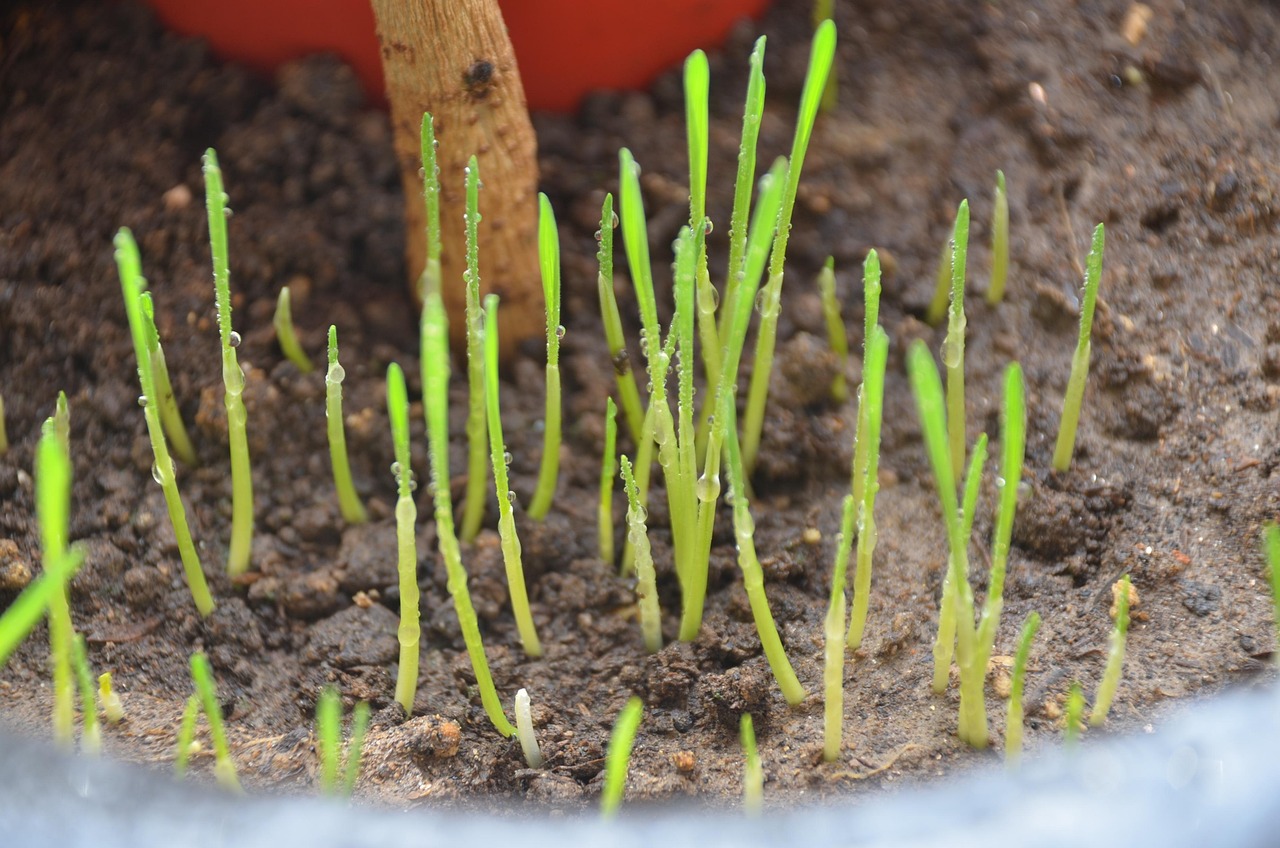Many people have noticed that tree trunks are often painted white, especially in orchards and parks. This practice serves several important purposes that contribute to the health of trees and the environment.
The painting of tree trunks, primarily with a white lime-based paint, is a common practice among gardeners and arborists. It may seem unusual at first, but this method has significant benefits that help protect trees from various environmental threats. Understanding the reasons behind this practice can shed light on effective tree care and management strategies.

One of the primary reasons for painting tree trunks white is to reflect sunlight. Young trees are particularly vulnerable to sunscald, which occurs when sunlight warms the bark during the day. When temperatures drop at night, the bark can crack. Painting the trunks helps to maintain a more stable temperature, reducing the likelihood of damage.
Additionally, the white color helps deter pests. Many insects are attracted to dark surfaces that absorb heat. By painting the trunks white, it creates an uninviting environment for these pests, ultimately protecting the tree’s health.
Benefits of Painting Tree Trunks White
The practice of painting tree trunks white offers several key benefits:
- Temperature Regulation: White paint reflects sunlight, helping to keep tree bark cool and stable.
- Pest Deterrence: The reflective surface discourages insects that prefer warmer, darker surfaces.
- Prevention of Disease: By protecting the bark from extreme temperature fluctuations, trees are less susceptible to diseases associated with stress.
- Aesthetic Appeal: In some cases, painted trunks enhance the visual appearance of landscapes.
Another critical benefit is related to frost protection. In colder climates, painted trunks can reduce frost damage by minimizing temperature variations in the bark. This is especially important for young trees, which are more sensitive to extreme conditions.
Moreover, the practice can be beneficial for fruit trees. For example, in orchards where fruit production is prioritized, maintaining healthy trees is essential for optimal yields. Painting trunks can help ensure that trees remain healthy and productive over time.
| Benefit | Description |
|---|---|
| Temperature Regulation | Minimizes damage from sunscald by reflecting sunlight. |
| Pest Deterrence | Discourages insects that thrive in warmer conditions. |
| Disease Prevention | Reduces stress-related diseases by stabilizing bark temperature. |
| Aesthetic Appeal | Adds visual interest to landscapes and gardens. |
In summary, painting tree trunks white is a simple yet effective practice that provides multiple advantages. By reflecting sunlight and regulating temperature, it protects trees from environmental stressors and enhances their overall health. This inexpensive method is widely adopted by both amateur gardeners and professional arborists alike.
Understanding the significance of this practice not only emphasizes the importance of tree care but also highlights how small actions can lead to substantial improvements in plant health and ecosystem sustainability.
Understanding the Materials Used for Painting
To effectively paint tree trunks, it is essential to understand the materials that can be used. Different formulations can yield varying results in terms of protection and durability. Here are some common materials used for this practice:
- Lime-based Paint: This traditional option is made from slaked lime and water. It is environmentally friendly and helps to enhance sunlight reflection.
- Latex Paint: Water-based latex paints can also be used. They provide a durable finish and are available in various colors, although white is often preferred.
- Tree Wraps: Instead of paint, some gardeners opt for tree wraps that offer similar benefits without altering the tree’s appearance.
Each of these materials has its advantages and disadvantages. Lime-based paint is cost-effective and biodegradable, making it a popular choice for those concerned about environmental impact. Latex paint offers a longer-lasting solution but may contain chemicals that are not as eco-friendly.
Application Techniques
Proper application is crucial for achieving the desired benefits from painting tree trunks. Here are some tips for effectively applying paint:
- Choose the Right Time: Apply paint in early spring or late fall when the temperatures are mild and stable.
- Prepare the Surface: Ensure the bark is clean and free from debris. If necessary, lightly scrub the trunk with a brush.
- Use the Right Tools: A brush or spray applicator can be used. Brushes allow for better control, while sprayers cover larger areas quickly.
- Apply Evenly: Ensure an even coat without over-saturation. A thin layer is often sufficient for effective protection.
Following these steps can maximize the effectiveness of the paint, ensuring that trees receive optimal protection against environmental stresses and pests.
Environmental Considerations

While painting tree trunks provides numerous benefits, it is also essential to consider the environmental implications of the materials used. Selecting eco-friendly options can reduce potential harm to surrounding ecosystems. Here are some points to consider:
- Biodiversity Protection: Using non-toxic materials helps to protect nearby plants, insects, and wildlife.
- Water Runoff: Ensure that any chemicals in the paint do not contaminate local water sources through runoff during rainstorms.
- Sustainability: Opt for materials that are sustainable or made from renewable resources to minimize ecological impact.
By being mindful of these factors, gardeners and arborists can make informed choices that benefit both trees and their surrounding environments.
Alternatives to Painting
While painting tree trunks is beneficial, some individuals may prefer alternatives. Here are a few methods that can provide similar protective effects:
- Tree Wraps: These wraps protect young trunks from sunscald and pests while allowing the tree to breathe.
- Mulching: Applying mulch around the base of a tree can help regulate soil temperature and moisture levels while preventing weed growth.
- Shade Cloth: Installing shade cloth during peak sunlight hours can offer temporary protection for vulnerable trees.
These alternatives can be effective in safeguarding trees, especially in specific contexts or for those who may prefer not to paint trunks directly.

Tree Species and Their Responses

Not all tree species react the same way to sunlight, temperature fluctuations, and pests. Understanding how different types of trees respond to these environmental factors can help in deciding whether to paint their trunks or use alternative methods. Here are a few notable species and their characteristics:
- Fruit Trees: Species like apple and peach trees are particularly susceptible to sunscald. Painting their trunks is often recommended to protect their bark and ensure healthy fruit production.
- Shade Trees: Trees such as oaks and maples may not require painting, as their thick bark provides natural protection against temperature extremes.
- Young Trees: Young saplings, regardless of species, benefit significantly from trunk painting due to their thin bark and vulnerability.
Recognizing the specific needs of each species can aid in developing effective tree care strategies. While some trees thrive without additional protection, others may need more support during their early growth stages.
The Role of Climate
Climate plays an important role in determining whether painting tree trunks is necessary. Regions with extreme temperature variations or intense sunlight can see more benefits from this practice. Here are some considerations based on climate:
- Tropical Climates: Trees in tropical areas may not require trunk painting since they experience consistent temperatures and humidity.
- Temperate Climates: In areas with distinct seasons, especially where winters are harsh, painting can protect trees from sunscald and frost damage.
- Arid Regions: In dry, sunny environments, the risk of sunburn increases. Painting trunks can help guard against damaging UV rays.
Understanding how climate affects tree health is essential for implementing effective care practices. In regions with harsh conditions, painting tree trunks could be a vital step in maintaining tree vitality.
Maintenance of Painted Trunks
Once tree trunks are painted, maintenance is crucial to ensure long-lasting protection. Regular inspections and touch-ups can help maintain the efficacy of the paint. Here are key maintenance tips:
- Regular Inspections: Check painted trunks periodically for peeling or fading paint, which can diminish protective benefits.
- Reapplication: Depending on the material used, reapply paint every one to three years to ensure continued protection.
- Damage Assessment: Look for signs of damage caused by pests or disease. Address any issues promptly to prevent further harm.
By adhering to these maintenance practices, tree owners can prolong the protective benefits of painted trunks and promote overall tree health.
Community and Educational Initiatives
Raising awareness about the importance of painting tree trunks and proper tree care can lead to healthier urban and suburban environments. Community initiatives can help foster a culture of care for local trees. Here are some ways communities can get involved:
- Workshops: Hosting workshops focused on tree care education can equip residents with the knowledge needed to properly care for trees in their area.
- Tree Adoption Programs: Programs that encourage individuals to adopt and care for local trees can help raise awareness about the importance of trunk painting.
- Collaboration with Arborists: Partnering with local arborists for tree health assessments can provide valuable insights into the specific needs of community trees.
Through such initiatives, communities can enhance the health of their urban forests and promote sustainable practices that benefit both people and the environment.
Long-Term Implications of Tree Trunk Painting
As communities continue to engage in the practice of painting tree trunks, it is essential to consider the long-term implications of this approach not only for individual trees but also for the ecosystem as a whole. The health of urban forests can significantly influence local biodiversity, air quality, and overall community wellness.
One major implication of maintaining painted tree trunks is that it promotes a proactive approach to tree care. By recognizing the importance of protecting tree bark, communities can foster a culture of sustainability. This practice can lead to healthier trees that provide numerous environmental benefits, including:
- Improved Air Quality: Healthy trees filter pollutants from the air and release oxygen, which is vital for human and animal life.
- Biodiversity Support: Well-maintained trees provide habitats for various wildlife species, promoting a balanced ecosystem.
- Temperature Regulation: Trees offer shade, which helps reduce urban heat islands and maintains cooler temperatures in cities.
Moreover, the aesthetic value of painted trees can enhance community spaces. Beautifully maintained landscapes can improve property values and attract tourism, making communities more vibrant and inviting.
The Importance of Education and Awareness
Education remains a cornerstone of successful tree care initiatives. As individuals become more aware of the benefits of painting tree trunks and the overall importance of maintaining healthy trees, they are more likely to take action. Educational programs can focus on:
- Tree Biology: Understanding how trees grow and respond to environmental factors can empower community members to engage in better care practices.
- Environmental Impact: Highlighting how trees contribute to the environment encourages individuals to value tree preservation.
- Practical Techniques: Teaching methods for painting and maintaining tree trunks ensures that residents feel equipped to care for their local trees.
By fostering education and awareness, communities can create a stronger sense of stewardship towards their green spaces.
Final Thoughts
The practice of painting tree trunks white may seem simple, but it encompasses significant benefits for both individual trees and the broader ecosystem. Through effective temperature regulation, pest deterrence, and disease prevention, painting trunks serves as a vital protective measure for numerous tree species. Additionally, understanding the materials used, application techniques, and maintenance requirements can enhance the effectiveness of this practice.
As communities engage in initiatives that promote tree trunk painting and overall forest health, they cultivate environments that support biodiversity, improve air quality, and enhance urban aesthetics. Educational efforts can further empower residents to become proactive stewards of their local trees, ensuring that future generations can enjoy the many perks that healthy trees provide.
Ultimately, the astonishing reason for painting tree trunks white is rooted in a commitment to sustaining our environment. By taking these relatively simple steps, we can make significant strides in preserving our natural surroundings and enhancing our quality of life.
